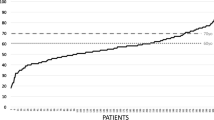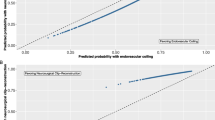Abstract
Background
Clinical prediction models can enhance clinical decision-making and research. However, available prediction models in aneurysmal subarachnoid hemorrhage (aSAH) are rarely used. We evaluated the methodological validity of SAH prediction models and the relevance of the main predictors to identify potentially reliable models and to guide future attempts at model development.
Methods
We searched the EMBASE, MEDLINE, and Web of Science databases from January 1995 to June 2012 to identify studies that reported clinical prediction models for mortality and functional outcome in aSAH. Validated methods were used to minimize bias.
Results
Eleven studies were identified; 3 developed models from datasets of phase 3 clinical trials, the others from single hospital records. The median patient sample size was 340 (interquartile range 149–733). The main predictors used were age (n = 8), Fisher grade (n = 6), World Federation of Neurological Surgeons grade (n = 5), aneurysm size (n = 5), and Hunt and Hess grade (n = 3). Age was consistently dichotomized. Potential predictors were prescreened by univariate analysis in 36 % of studies. Only one study was penalized for model optimism. Details about model development were often insufficiently described and no published studies provided external validation.
Conclusions
While clinical prediction models for aSAH use a few simple predictors, there are substantial methodological problems with the models and none have had external validation. This precludes the use of existing models for clinical or research purposes. We recommend further studies to develop and validate reliable clinical prediction models for aSAH.

Similar content being viewed by others
References
Steyerberg EW. Clinical prediction models. A practical approach to development, validation and updating. New York: Springer; 2009.
Al-Khindi T, Macdonald RL, Schweizer TA. Cognitive and functional outcome after aneurysmal subarachnoid hemorrhage. Stroke. 2010;41:e519–36.
Lovelock CE, Rinkel GJ, Rothwell PM. Time trends in outcome of subarachnoid hemorrhage: Population-based study and systematic review. Neurology. 2010;74:1494–501.
den BS, de Keizer NF, de JE. Performance of prognostic models in critically ill cancer patients—a review. Crit Care. 2005;9:R458–63.
Ariesen MJ, Algra A, van der Worp HB, Rinkel GJ. Applicability and relevance of models that predict short term outcome after intracerebral haemorrhage. J Neurol Neurosurg Psychiatry. 2005;76:839–44.
Beneciuk JM, Bishop MD, George SZ. Clinical prediction rules for physical therapy interventions: a systematic review. Phys Ther. 2009;89:114–24.
Toll DB, Janssen KJ, Vergouwe Y, Moons KG. Validation, updating and impact of clinical prediction rules: a review. J Clin Epidemiol. 2008;61:1085–94.
Mallett S, Royston P, Waters R, Dutton S, Altman DG. Reporting performance of prognostic models in cancer: a review. BMC Med. 2010;8:21.
Noterman J, Brotchi J. A brief history and a few remarks about classifications of aneurysmal subarachnoid hemorrhages and scales of follow-up. Neurochirurgie. 2006;52:83–92.
van Gijn J, Bromberg JE, Lindsay KW, Hasan D, Vermeulen M. Definition of initial grading, specific events, and overall outcome in patients with aneurysmal subarachnoid hemorrhage. A survey [Review] [24 refs]. Stroke. 1994;25:1623–7.
Cavanagh SJ, Gordon VL. Grading scales used in the management of aneurysmal subarachnoid hemorrhage: a critical review. J Neurosci Nurs. 2002;34:288–95.
Ducati A. The clinical grading of subarachnoid hemorrhage [Review] [8 refs] [Italian]. Minerva Anestesiol. 1998;64:109–12.
Rosen DS, Macdonald RL. Subarachnoid hemorrhage grading scales: a systematic review. Neurocrit Care. 2005;2:110–8.
Tamargo RJ, Walter KA, Oshiro EM. Aneurysmal subarachnoid hemorrhage: prognostic features and outcomes [Review] [70 refs]. New Horiz. 1997;5:364–75.
Moher D, Liberati A, Tetzlaff J, Altman DG. Preferred reporting items for systematic reviews and meta-analyses: the PRISMA statement. BMJ. 2009;339:b2535.
Ingui BJ, Rogers MA. Searching for clinical prediction rules in MEDLINE. J Am Med Inform Assoc. 2001;8:391–7.
Risselada R, Lingsma HF, Bauer-Mehren A, et al. Prediction of 60 day case-fatality after aneurysmal subarachnoid haemorrhage: results from the International Subarachnoid Aneurysm Trial (ISAT). Eur J Epidemiol. 2010;25:261–6.
Risselada R, Lingsma HF, Molyneux AJ, et al. Prediction of two month modified Rankin Scale with an ordinal prediction model in patients with aneurysmal subarachnoid haemorrhage. BMC Med Res Methodol. 2010;10:86.
Le Roux PD, Elliott JP, Newell DW, Grady MS, Winn HR. Predicting outcome in poor-grade patients with subarachnoid hemorrhage: a retrospective review of 159 aggressively managed cases. J Neurosurg. 1996;85:39–49.
Mocco J, Ransom ER, Komotar RJ, et al. Preoperative prediction of long-term outcome in poor-grade aneurysmal subarachnoid hemorrhage. Neurosurgery. 2006;59:529–38.
Claassen J, Vu A, Kreiter KT, et al. Effect of acute physiologic derangements on outcome after subarachnoid hemorrhage. Crit Care Med. 2004;32:832–8.
Turck N, Vutskits L, Sanchez-Pena P, et al. A multiparameter panel method for outcome prediction following aneurysmal subarachnoid hemorrhage. Intensive Care Med. 2010;36:107–15.
Germanson TP, Lanzino G, Kongable GL, Torner JC, Kassell NF. Risk classification after aneurysmal subarachnoid hemorrhage. Surg Neurol. 1998;49:155–63.
Lagares A, Gomez PA, Alen JF, et al. A comparison of different grading scales for predicting outcome after subarachnoid haemorrhage. Acta Neurochir (Wien). 2005;147:5–16.
Ogilvy CS, Quinones-Hinojosa A. Surgical treatment of vertebral and posterior inferior cerebellar artery aneurysms [Review] [51 refs]. Neurosurg Clin N Am. 1998;9:851–60.
Rosen DS, Macdonald RL. Grading of subarachnoid hemorrhage: modification of the World Federation of Neurosurgical Societies scale on the basis of data for a large series of patients. Neurosurgery. 2004;54:566–75.
Salary M, Quigley MR, Wilberger JE Jr. Relation among aneurysm size, amount of subarachnoid blood, and clinical outcome. J Neurosurg. 2007;107:13–7.
de TP, Rios PM, Ledezma A, Sanchis A, Alen JF, Lagares A. Predicting the outcome of patients with subarachnoid hemorrhage using machine learning techniques. IEEE Trans Inf Technol Biomed. 2009;13:794–801.
Degen LA, Dorhout Mees SM, Algra A, Rinkel GJ. Interobserver variability of grading scales for aneurysmal subarachnoid hemorrhage. Stroke. 2011;42:1546–9.
Smith ML, Abrahams JM, Chandela S, Smith MJ, Hurst RW, Le Roux PD. Subarachnoid hemorrhage on computed tomography scanning and the development of cerebral vasospasm: the Fisher grade revisited. Surg Neurol. 2005;63:229–34.
Frontera JA, Claassen J, Schmidt JM, et al. Prediction of symptomatic vasospasm after subarachnoid hemorrhage: the modified Fisher scale. Neurosurgery. 2006;59:21–7.
Jennett B, Bond M. Assessment of outcome after severe brain damage. A practical scale. Lancet. 1975;1:480–4.
van Swieten JC, Koudstaal PJ, Visser MC, Schouten HJ, van GJ. Interobserver agreement for the assessment of handicap in stroke patients. Stroke. 1988;19:604–7.
Mushkudiani NA, Hukkelhoven CW, Hernandez AV, et al. A systematic review finds methodological improvements necessary for prognostic models in determining traumatic brain injury outcomes. J Clin Epidemiol. 2008;61:331–43.
Whiteley W, Chong WL, Sengupta A, Sandercock P. Blood markers for the prognosis of ischemic stroke: a systematic review. Stroke. 2009;40:e380–9.
Mocco J, Ransom ER, Komotar RJ, et al. Racial differences in cerebral vasospasm: a systematic review of the literature. Neurosurgery. 2006;58:305–14.
Bossuyt PM, Reitsma JB, Bruns DE, et al. Towards complete and accurate reporting of studies of diagnostic accuracy: the STARD Initiative. Ann Intern Med. 2003;138:40–4.
Altman DG, McShane LM, Sauerbrei W, Taube SE. Reporting recommendations for tumor marker prognostic studies (REMARK): explanation and elaboration. PLoS Med. 2012;9:e1001216.
Moher D, Schulz KF, Altman D. The CONSORT statement: revised recommendations for improving the quality of reports of parallel-group randomized trials. JAMA. 2001;285:1987–91.
Moher D, Liberati A, Tetzlaff J, Altman DG. Preferred reporting items for systematic reviews and meta-analyses: the PRISMA statement. J Clin Epidemiol. 2009;62:1006–12.
Acknowledgments
Funded by a Grant from the Canadian Institutes for Health Research.
Disclosures
Michael D. Cusimano receives grant support from the Canadian Institutes for Health Research. Nima Etminan receives grant support from the Physicians Services Incorporated Foundation. David Hasan receives grant funding from the National Institutes of Health and Brain Aneurysm Foundation. Peter Le Roux receives research funding from the National Institutes of Health and Integra and is a consultant for Codman, Integra, and Edge Therapeutics. R. Loch Macdonald receives grant funding from the Canadian Institutes for Health Research, Heart and Stroke Foundation of Canada, Canadian Stroke Network, Brain Aneurysm Foundation, and Physicians Services Incorporated Foundation. He is a consultant for Actelion Pharmaceuticals, Ltd. and the Chief Scientific Officer of Edge Therapeutics, Inc. Stephan Mayer is a consultant for Actelion Pharmaceuticals, Ltd. Andrew Molyneux is a consultant for Micrus Endovascular and receives Grant support from the Medical Research Council UK and Cerecyte Coil Trial. Tom A. Schweizer receives grant support from the Heart and Stroke Foundation of Canada, the Canadian Institutes of Health Research, and the Ontario Ministry of Research and Innovation. Michael Todd receives grant support from the National Institutes of Health. James Torner receives grant support from the National Institutes of Health. Mervyn D. I. Vergouwen receives Grant support from the Netherlands Thrombosis Foundation and Netherlands Heart Foundation. George K. C. Wong receives grant support from the Hong Kong Food and Health Bureau and the Hong Kong University Grant Committee.
Author information
Authors and Affiliations
Corresponding author
Additional information
This study was conducted for the SAHIT Collaboration.
Rights and permissions
About this article
Cite this article
Jaja, B.N.R., Cusimano, M.D., Etminan, N. et al. Clinical Prediction Models for Aneurysmal Subarachnoid Hemorrhage: A Systematic Review. Neurocrit Care 18, 143–153 (2013). https://doi.org/10.1007/s12028-012-9792-z
Published:
Issue Date:
DOI: https://doi.org/10.1007/s12028-012-9792-z




